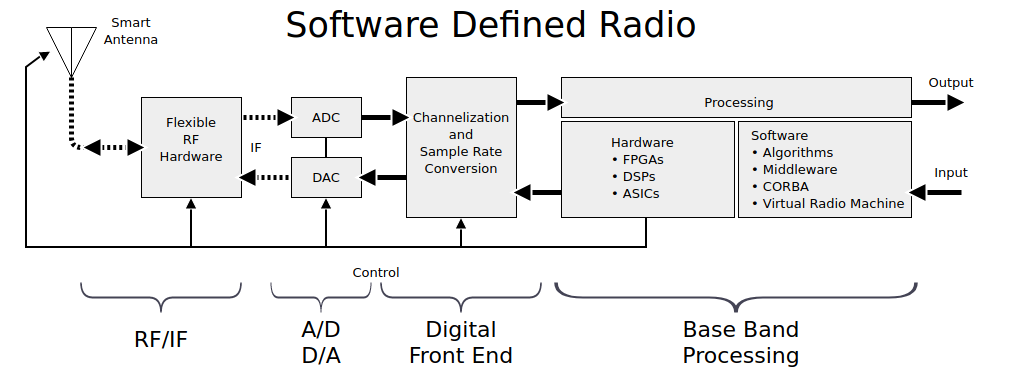Physical layer
At the very bottom layer of any communication system, there is a signal varying over time, transported over a physical channel. A protocol’s physical OSI layer deals with all properties of this channel and prescribes a way to use it for transmission.
Channel capacity
The theoretical upper bound for a channel’s net bit rate in bits/s:
\[C = B~{\rm log}_2 (1+{\rm SNR})\]Where:
- B: bandwidth (Hertz)
- SNR: signal to noise ratio
Conclusions:
- For faster bit rate, we can work on the SNR or be more greedy on bandwidth (if available)
- If bit rate is not critical, transmission can (almost) always be achieved no matter how bad the SNR. For instance, Voyager 1 used to transmit at 21.6 kb/s and is now down to 160 b/s.
Spectrum
When looking at the transmitted signal in the frequency domain, a few things become obvious:
- Some parts of the spectrum are not available or can’t be physically reached (high frequencies)
- Perfect square waves cannot exist in the real world!
- Narrowband modulation is convenient for slicing up bands in several channels
Copper wires
This is the earliest example of physical layer, starting with telegraph lines. Information is usually carried by a voltage varying over time, sent from the transmitter to the receiver.
A popular model for the impedance of an element of copper line is an RLC(+G) circuit:

Integrating this element over the whole line and solving the so-called telegrapher’s equations provides us with the characteristic impedance of the line:
\[Z_0 = \sqrt{\frac{R+j\omega L}{G+j\omega C}}\]This is the perceived impedance from the emitter’s viewpoint, if the line properly terminated with an impedance-matched termination resistor. Otherwise, reflections come back and degrade the signal, leading to perceived noise.
 source: https://zone.ni.com/reference/en-XX/help/370592AB-01/digitizers/impedance_and_impedance_matching/
source: https://zone.ni.com/reference/en-XX/help/370592AB-01/digitizers/impedance_and_impedance_matching/
One good practice is to twist the wire pair to mitigate interference caused by an external magnetic flux.

Radio
Radio domain is dominated by narrowband communication, so that several bands can be defined and used for different purposes. Current applications for ultra wideband are mostly radar and tracking.
 source: https://www.researchgate.net/profile/Rashid-Fayadh/publication/286584218
source: https://www.researchgate.net/profile/Rashid-Fayadh/publication/286584218
Modern narrowband communication encodes several bits into a single symbol, mapped to a specific amplitude and phase applied on the carrier wave.
 source: A. Skidin, O. Sidelnikov, M. Fedoruk, and S. Turitsyn, “Mitigation of nonlinear transmission effects for OFDM 16-QAM optical signal using adaptive modulation,” Opt. Express 24, 30296-30308 (2016).
source: A. Skidin, O. Sidelnikov, M. Fedoruk, and S. Turitsyn, “Mitigation of nonlinear transmission effects for OFDM 16-QAM optical signal using adaptive modulation,” Opt. Express 24, 30296-30308 (2016).
Orthogonal frequency-division multiplexing (OFDM) is now widely used in 4G (and 5G) networks, it’s the most efficient scheme for packing sub-carriers in a limited band. The sub-carriers are seemingly overlapping each other but are carefully designed to be fully recoverable at demodulation, providing an effective bandwidth of exactly one OFDM band.
 source: http://rfmw.em.keysight.com/wireless/helpfiles/89600b/webhelp/subsystems/wlan-ofdm/Content/ofdm_basicprinciplesoverview.htm
source: http://rfmw.em.keysight.com/wireless/helpfiles/89600b/webhelp/subsystems/wlan-ofdm/Content/ofdm_basicprinciplesoverview.htm
Another important modern feature is multiple-input, multiple-output (MIMO), in which an array of emitting antenna communicates with an array of receivers. With various multiplexing schemes (frequency and orthogonal codes), the mangled data can be perfectly recovered, leading to a linear increase in throughput.
Software defined radios (SDR) are amazing little devices that can process the baseband signal in arbitrary ways, allowing prototyping of novel protocols. The processing of the captured samples can be offloaded to a computer, or performed by an embedded device (e.g. FPGA).
 source: https://payatu.com/blog/appar/iot-security-%E2%80%93-part-8-introduction-to-software-defined-radio-sdr
source: https://payatu.com/blog/appar/iot-security-%E2%80%93-part-8-introduction-to-software-defined-radio-sdr
Frameworks and tools for SDR:
Optical
 source: https://news.fit.edu/archive/cant-live-without-fiber-optics/
source: https://news.fit.edu/archive/cant-live-without-fiber-optics/
In optical systems, information is carried by visible wavelengths. Compared with radio frequencies, the potential increase in bitrate is obvious, although there are serious challenges to overcome. As visible light is easily blocked, it needs to guided in a medium with low dispersion and attenuation. The most popular medium is now optical fibers, which make use of total reflection between the core and cladding due to a difference in refractive index so that very efficient propagation modes appear at some given frequencies.
- Bit rate world record: a whopping 172 tb/s using spatial multiplexing in only 3 cores, 1 mode in each.
- Quantum entanglement: entangled single photon transmission
- Starlink: achieves lower latency than grounded fiber optics thanks to the lower dispersion in the (relative) vacuum at that altitude.